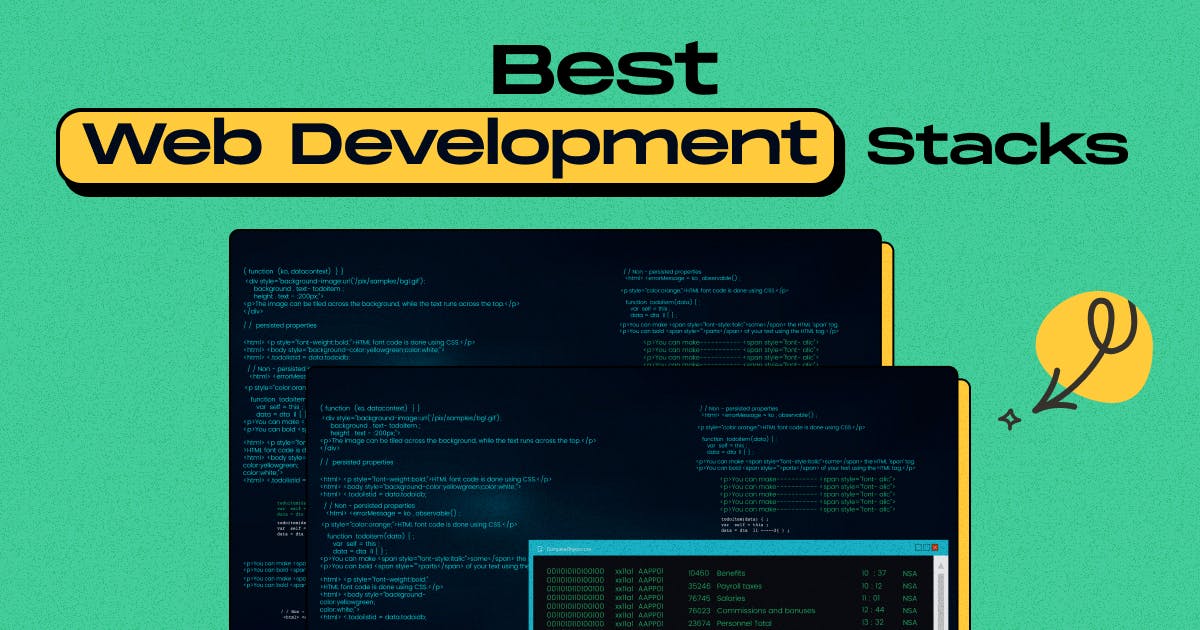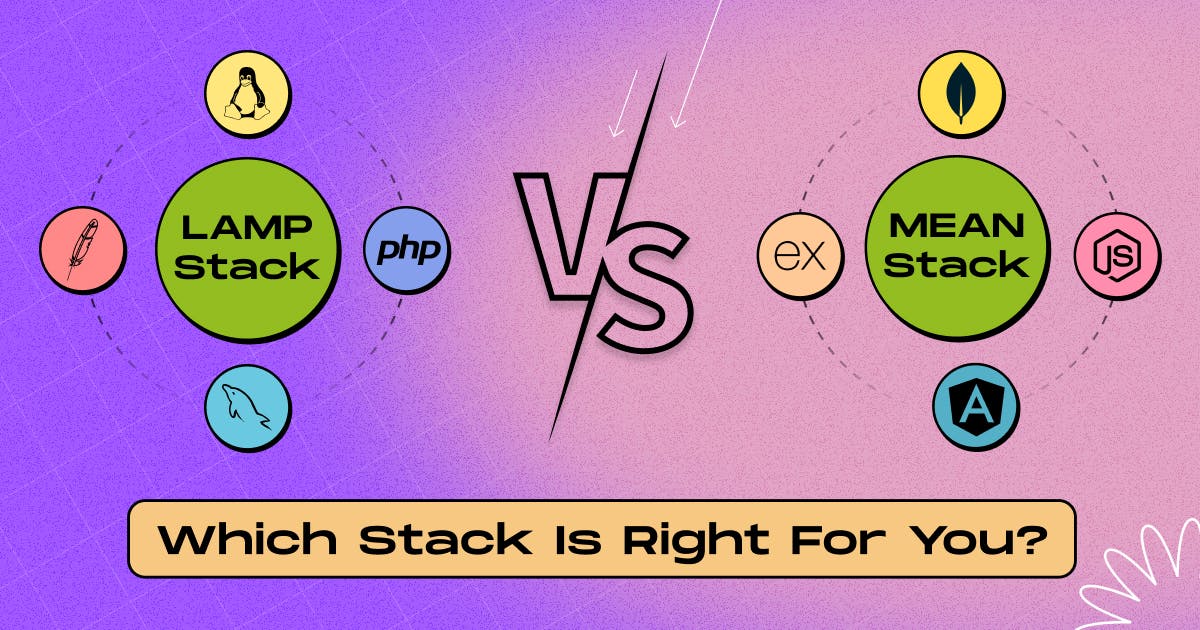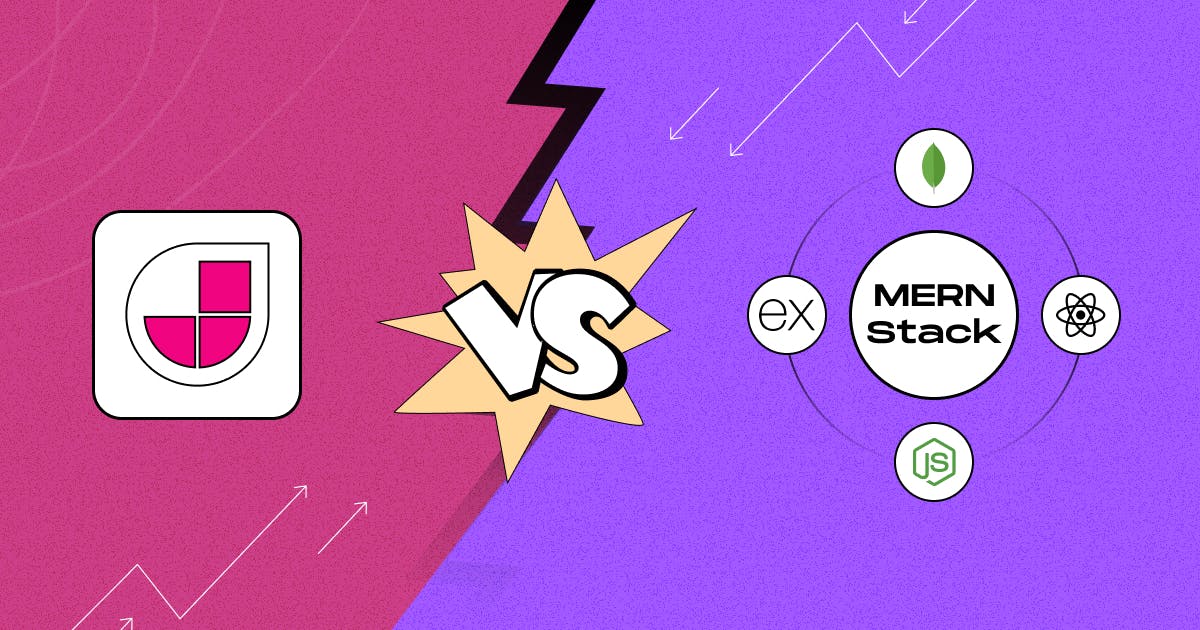November 16, 2023
Best Web Development Stacks to Use

Nusrat Sarmin

The world of web development is a vibrant and ever-transforming realm, where cutting-edge technologies and tools emerge at a rapid pace.
Are you curious to know which web development technology stacks are going to roll out in 2024? 🤔
Introducing the ultimate guide to the best web development stacks of 2024, packed with insightful information and eye-opening observations.
Let’s dive into the next part:
What Is a Web Development Stack?
A web development stack is a combination of software components and technologies used to create applications or websites. It is a combination of programming languages, frameworks, libraries, tools, and services to build and maintain web applications. A development stack provides an all-encompassing, structured framework for both client-side and server-side functionalities.
A web development stack typically consists of three key components:
➽ Front-end:
This is the presentation layer of the website that end-users can see and interact with directly in their browsers. Front-end technologies are responsible for user interface (UI) and user experience (UX).
The key front-end technologies include HTML (Hypertext Markup Language), CSS (Cascading Style Sheets), and JavaScript.
➽ Back-end:
The "back-end" of a web application is the part responsible for server-side processing and handling requests from the front end. It's where data processing, user authentication, and other server-side tasks occur.
Common programming languages used for back-end development include Node.js, Python, Ruby, Java, PHP, and more. Besides, popular back-end frameworks include Express.js, Ruby on Rails, Django, Spring, etc.
➽ Database:
The database is where an application stores, retrieves, and manages data. The back-end interacts with the database to perform tasks like data storage and retrieval. There are two primary types of databases: relational databases (e.g., MySQL, PostgreSQL) and NoSQL databases (e.g., MongoDB, Cassandra).
What are the Best Web Development Stacks to Use in 2024?
Now, let's explore some of the best web development stacks that are expected to be in use by 2024.
❶ The MERN Stack
MongoDB | Express.js | React | Node.js.
This is one of the most popular web development stacks right now and is likely to remain a popular choice for the foreseeable future.
MERN provides developers with a powerful combination of open-source technologies: MongoDB, Express.js, React, and Node.js. It allows developers to use JavaScript throughout the full stack.
This tech stack provides developers with end-to-end solutions for building dynamic, interactive, feature-rich, modern web applications. The MERN stack is a go-to solution for modern web applications due to its scalability, flexibility, and ease of development.
✔ MongoDB: The Database Layer, which is a NoSQL, document-oriented database. It provides a versatile and efficient way to store and manage your application's data.
✔ Express.js: The Back-End Framework, is a minimal and flexible Node.js framework to simplify server-side development.
✔ React: The Front-End Library, a JavaScript library developed by Facebook, is ideal for a top-notch and intuitive user interface.
✔ Node.js: The Server-Side Runtime, a JavaScript runtime for server-side rendering and building APIs. It allows for fast, efficient, and secure backend development.
MERN Stack Pros and Cons
| Pros | Cons |
|---|---|
|
|
❷ MEAN Stack
MongoDB | Express.js | Angular | Node.js
The MEAN stack is another open-source JavaScript stack that is very similar to the MERN stack. The only difference is that while the MERN stack uses React for the front end, the MEAN stack uses Angular.
Angular is a powerful front-end framework developed and maintained by Google. It's a comprehensive front-end framework for building complex, feature-rich applications.
Key features of Angular include:
➤ Two-Way Data Binding: Angular offers data binding that synchronizes the model and the view, which helps minimize the need for manual DOM manipulation.
➤ Component-Based Architecture: It promotes modular development by breaking the application into reusable components.
➤ Dependency Injection: Angular's dependency injection system simplifies component dependencies.
MEAN is well suited for building dynamic single-page applications (SPAs) and real-time applications. This stack is suitable for startups and enterprises aiming to develop web applications efficiently and quickly with low budgets.
Pros and Cons of MEAN Stack
| Pros | Cons |
|---|---|
|
|
❸ LAMP Stack
Linux | Apache | MySQL | PHP/Perl/Python
The LAMP stack has been a classic choice for web development for many years. It is one of the oldest open-source stacks that is more than 20 years old. But still, LAMP is considered an industry-standard web development stack. In 2024, it is expected to remain one of the best web development stacks; due to its reliable foundation for creating dynamic websites.
The legacy of LAMP continues to flourish, proving that the classics never go out of style.
Many small to medium-sized business websites rely on the LAMP stack for its simplicity, efficiency, and versatility. Popular CMS platforms like Joomla, Drupal, and WordPress rely on LAMP for content storage and dynamic web content generation.
✔ Linux: The operating system: a Unix-like operating system renowned for its stability, security, and open-source nature. Linux is a great choice for hosting web applications because it is robust and secure.
✔ Apache: A popular web server: one of the most widely used web servers on the planet. Provides Strong performance and security features.
✔ MySQL:A relational database management system: MySQL's relational database capabilities enable you to store and manage data efficiently. It is known for its excellent performance, wide adoption, rich ecosystem, and strong community.
✔ PHP/Perl/Python: The Scripting Languages: The final component in LAMP is a server-side scripting language, represented by the letter "P". PHP, Perl, and Python are commonly used for this role.
Pros and Cons of LAMP Stack
| Pros | Cons |
|---|---|
|
|

LAMP vs. MEAN: Which Stack Is Right For You?
❹ The MEVN Stack
MongoDB | Express.js | Vue.js | Node.js
The MEVN stack is very similar to two prior stacks MERN and MEAN. The main difference among these stacks is the choice of frontend framework, while the other two use react and angular respectively, MEVN uses Vue.js for the frontend.
➤ Vue.js is known for its simplicity, ease of integration, and lightweight nature.
➤ Vue.js's component-based architecture makes it easy to reuse and manage UI elements, while its reactivity system ensures that your application remains responsive.
➤ Vue is designed to be incrementally adaptable and flexible. Allowing developers to integrate the MEVN stack into their projects at their own pace, depending on their use case.
Whether you're building a simple website or a complex web application, the MEVN stack can help you stay at the forefront of web development.
Its flexibility, scalability, and rich ecosystem of libraries and tools make it a viable choice. However, in the case of larger projects or when extensive ecosystems and capabilities are required, the MERN or MEAN stack may be more suitable.
Pros and Cons of MEVN Stack
| Pros | Cons |
|---|---|
|
|
❺ The Serverless Stack
The serverless web development stack is built on the principles of serverless computing. Serverless computing is a cloud-based computing model. It involves writing code as functions or microservices that are executed in response to events, such as HTTP requests, database changes, or scheduled tasks.
It allows developers to focus on writing code without worrying about infrastructure or server management.
The serverless web development stack represents the future of web development, offering scalability, cost-efficiency, and reduced management overhead.
Key Components of the Serverless Stack Are:
➤ Frontend: The frontend of your web application, comprising HTML, CSS, and JavaScript.
➤ Serverless Backend: The backend logic of your web application is implemented using serverless functions. Popular serverless services for the backend include AWS Lambda, Azure Functions, and Google Cloud Functions.
➤ API Gateway: An API Gateway acts as a bridge between the front end and the back end.
➤ Database: Serverless databases like Amazon DynamoDB or serverless SQL databases are used.
Pros and Cons of Serverless Stack
| Pros | Cons |
|---|---|
|
|
❻ The Django Stack
Python | Django | PostgreSQL or MySQL
The Django stack, often referred to as the Django web stack or Django architecture. This stack is a set of software and best practices to create robust web applications. Django is a Python web framework that offers a structured and efficient approach to developing web applications.
The Django stack provides a solid foundation for building web applications that require robust security and a rapid development cycle. It follows the Model-View-Template (MVT) architectural pattern.
Pros and Cons of Django Stack
| Pros | Cons |
|---|---|
|
|
❼ JAMstack
JavaScript | APIs | Markup (Static Site Generators)
JAMstack is one of the latest approaches to web development that offers numerous benefits over traditional methods. It revolutionized the way we build websites.
Jamstcak works by separating the front-end from the back-end and using APIs as the bridge between the two layers. Its static nature, combined with dynamic capabilities through APIs, results in fast, reliable, and cost-effective solutions.
Key Components Include:
➤ Client-Side JavaScript: JavaScript is used for dynamic functionalities. It runs on the client side and reduces the server workload.
Pre-built Markup: Markup refers to the HTML that's prebuilt during the build process.
➤ APIs for Dynamic Content: API connects the presentation layer and database layer. These APIs can be third-party services or custom-built. It handles tasks such as database management, user authentication, and third-party integrations.
➤ CDN for Content Delivery: Content Delivery Network (CDN) services are used to serve content to the end-users.
Pros and Cons of JAMstack
| Pros | Cons |
|---|---|
|
|

MERN Stack vs Jamstack: Chose Your Best One
How to Choose the Best Web Development Stacks for Your Next Project?
The "best" stack depends on your project's requirements and budget, the skills of your team, and your personal preferences. Each web development project is unique and needs specific tools and technologies for success.
Begin by thoroughly understanding your project's objectives, complexity, scope, and target audience. What features and functionalities do you need? Are there any specific technical or business requirements? When choosing a web development stack, it's also important to consider factors like scalability, security, and community support.
Wrap-up Discussion - Best Web Development Stacks in 2024
As technology continues to evolve, so does the web development landscape. Deciding the most suitable web development stack for a project in 2024 may be challenging due to the numerous emerging frameworks, languages, and tools. However, with an understanding of the current trends and an eye toward future advancements, developers can make informed decisions regarding the most advantageous technology stack for their projects.
The Best Web Development Stacks in 2024 at a glance
✪ The MERN Stack - MongoDB | Express.js | React | Node.js.
✪ The MEAN Stack - MongoDB | Express.js | Angular | Node.js
✪ The LAMP Stack - Linux | Apache | MySQL | PHP/Perl/Python
✪ The MEVN Stack - MongoDB | Express.js | Vue.js | Node.js
✪ The Serverless Stack - Cloud Computing Model
✪ The Django Stack - Python | Django | PostgreSQL or MySQL
✪ The JAMStack - JavaScript | APIs | Markup
Are you on a journey to create a fantastic web application but feeling a bit lost in the wilderness of technology stacks? Don't worry; StaticMania is ready to help you. Let's discuss finding the right web development stack!
Note: Our editorial team independently picked and reviewed each of the products, frameworks, and platforms we listed. All of the mentioned product’s features and other information were collected independently and dependent on the date this article was published. We cordially request that, before making any decision, please visit the featured websites. Posts may contain affiliate links.

